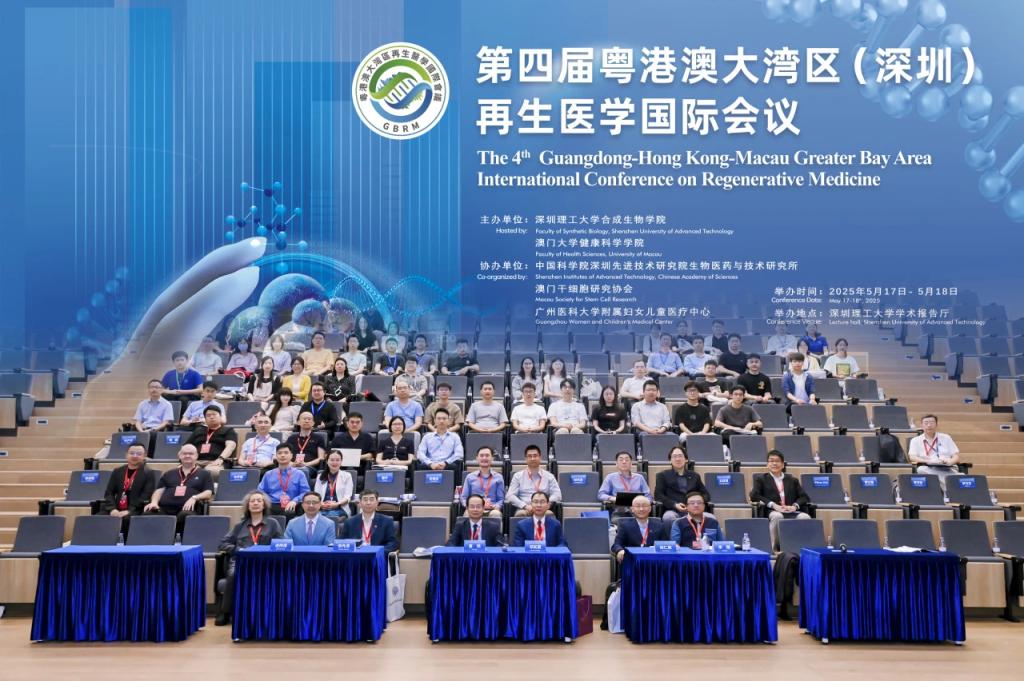
On May 17–18, 2025, the 4th Guangdong-Hong Kong-Macau Greater Bay Area International Conference on Regenerative Medicine, co-hosted by the Faculty of Synthetic Biology at Shenzhen University of Advanced Technology (SUAT) and the Faculty of Health Sciences at the University of Macau, was successfully held at SUAT’s International Exchange Center. Marking its first time in Shenzhen, the conference attracted over 30 renowned scholars, clinical experts, and industry leaders from China, the United States, Japan, South Korea, Singapore, and the Greater Bay Area. The event fostered in-depth discussions on cutting-edge regenerative medicine technologies, interdisciplinary integration, and clinical translation, offering new perspectives for global healthcare.
Professor Qizhou Lian from the Faculty of Synthetic Biology of SUAT, the conference initiator and executive chair, delivered the opening address, stating: “Regenerative medicine is transitioning from basic research to a critical phase of clinical translation. Moving forward, we must focus on three key directions: accelerating the clinical application of laboratory results, strengthening the ‘research-clinical-industry’ synergy in the Greater Bay Area, and promoting global consensus on regenerative medicine ethics and standards.”
Professor Wei Zhao, SUAT’s Provost, emphasized that SUAT will deepen collaboration with the University of Macau in life sciences, materials science, big data, and computer science, jointly building interdisciplinary innovation platforms to support global health technology development.
Professor Wei Ge, Vice-Rector of the University of Macau, highlighted that both institutions will collaborate to build a biomedical innovation ecosystem in the Greater Bay Area, promoting deep integration of industry, academia, and research.
Professor Xian-En Zhang, Dean ofthe Faculty of Synthetic Biology of SUAT, outlined the conference’s core theme: “The conference centers on the interdisciplinary innovation of regenerative medicine and synthetic biology, focusing on frontier fields such as stem cell therapy, gene editing, and AI-driven drug development. We aim to establish a full-chain translation mechanism of ‘basic research-technology development-clinical application’. Leveraging the advantages of our synthetic biology infrastructure cluster, we will collaborate with Greater Bay Area research institutions to tackle key technological challenges in regenerative medicine.”
Professor Renhe Xu from the Faculty of Health Sciences at the University of Macau reviewed the conference’s four-year journey, starting in Macau, progressing through Zhuhai and Hong Kong, and now landing in Shenzhen.The conferencehas become an internationally influential academic platform, witnessing the rapid advancement of regenerative medicine in the Greater Bay Area.
Professor Chuxia Deng, Dean of the Faculty of Health Sciences at the University of Macau, shared future plans, announcing that the conference aims to evolve into an “International Regenerative Medicine Alliance” to deepen global industry-academia-research collaboration and advance technological innovation and human health.
Six Core Topics Driving Medical Breakthroughs:
Emerging Technologies and AI for Medicine:Exploring AI applications in drug development and precision diagnostics.
Stem Cell and Synthetic Biology:Investigating cutting-edge technologies for life design and organ regeneration.
Ethics in Stem Cell Biology:Balancing technological advancements with ethical governance.
Stem Cell and Regenerative Medicine:Analyzing stem cell microenvironment regulation and new strategies for organ repair.
Translational Medicine and New Instruments:Promoting the translation of laboratory results to clinical and industrial applications.
Clinical Gene and Immunological Therapy:Sharing progress in CAR-T cell therapy, gene editing, and other clinical advancements.
The conference featured aYoung Scientists’ Presentationssession, providing an international stage for emerging researchers to showcase innovative results and fostering the growth of scientific talent.
Amid surging global healthcare demands, regenerative medicine offers new hope for intractable diseases through innovations in stem cell technology, synthetic biology, and AI-enabled therapies. As a national hub for technological innovation, the Greater Bay Area drives a dual-engine model of “clinical needs + research capabilities”, establishing a complete innovation chain from basic research to industrial application. Through deepened industry-academia-research collaboration, SUAT and the University of Macau leverage world-leading technology platforms and Shenzhen’s special economic zone policy advantages to achieve breakthroughs in key areas such as organ repair and gene technology. This collaboration builds a full-chain innovation system of “basic research-clinical validation-industrial application”, positioning the Greater Bay Area as a globally influential biomedical innovation hub.
